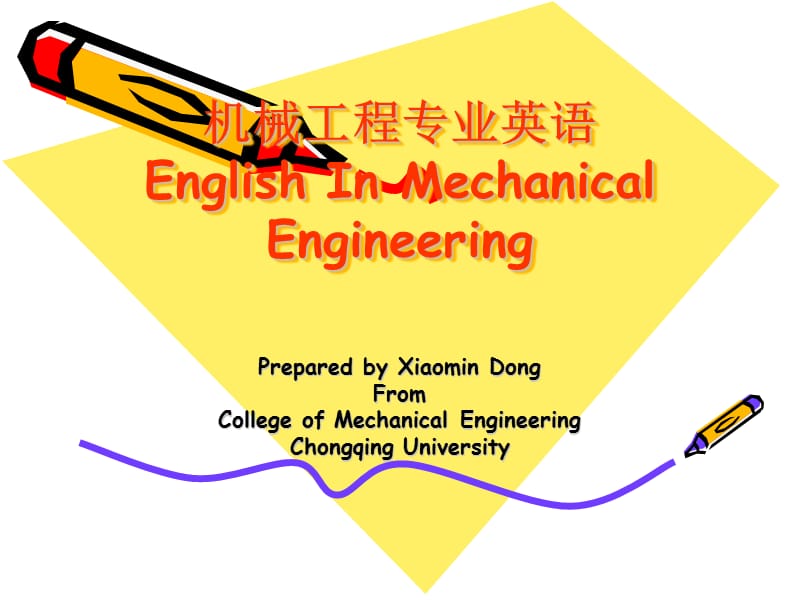《【重慶大學(xué) 專業(yè)英語(yǔ)】Manufacturing Technology》由會(huì)員分享�,可在線閱讀,更多相關(guān)《【重慶大學(xué) 專業(yè)英語(yǔ)】Manufacturing Technology(8頁(yè)珍藏版)》請(qǐng)?jiān)谘b配圖網(wǎng)上搜索�。
1、機(jī)械工程專業(yè)英語(yǔ)English In Mechanical Engineering,Prepared by Xiaomin Dong From College of Mechanical Engineering Chongqing University,58 Manufacturing Technology,Very simply�,manufacturing is converting raw materials into usable products. A further refinement of this fundamental definition is that these pro
2、ducts may be reproduced in quantity�����,at a quality which makes them functional����,and at a cost which makes them competitive. There is a basic difference,therefore��,between an artisan who design and crafts a single chair���,and a number of workers involved in building a quantity of identical chairs. This act
3���、 of replication requires the organization of product design����,materials�����,special tools and equipment�����,skilled people�,and a management team into a productive system.,58 Manufacturing Technology,The processes involved in converting materials into products can be classified as forming����,cutting,and assemblin
4�、g. Ultimately,these are the only acts one can impose upon a substance to change it into something which people can use. Furthermore����,these changes imposed upon materials are designed to produce modifications in the mass or bulk of the material��,so that a subsequent change in geometry or shape occurs.
5�、These modifications can be described as mass or bulk conserving(forming)�,mass or bulk reducing(cutting),and mass or bulk increasing (assembling).Stated another way��,the geometry or configuration of a material can be changed by moving materials from one area to another���,removing unnecessary material�����,or
6�、 joining materials together.,58 Manufacturing Technology,Forming is a mass or bulk conserving process���,where shape change is achieved by deformation. The bulk of the end product is equal�,or almost equal���,to the initial bulk of the workpiece or raw substance. The fundamental forming processes include b
7�、ending�,drawing,rolling,forging�,extruding,and casting. In all but casting���,the geometry change is effected by deformation. Metal can be squeezed����,stretched�,or twisted to produce various shapes. The casting of metals or ceramics involves the introduction of a fixed amount of material into a mold cavity.
8、 The material is conserved���;only the precise amount needed goes into the finished product. Nothing is cut away to form the final shape and size at great economy��,and with certain structural attributes. And��,generally�����,it costs less.,58 Manufacturing Technology,Cutting is a mass or bulk reduction process
9、�����,where shape change is achieved by removing material particles or chips until the workpiece has the desired geometry. Cutting is also a separation process��,where a part size is diminished by trimming or shearing to a specified dimension. Cutting therefore differs from hot or cold forming,where bulk d
10���、eformation is employed to create a new shape�,but where no gross part of the workpiece is removed. Many shapes produced by cutting can be made hot or cold forming or by casting. The greatest advantage of cutting is the ability to produce intricate shapes having extremely accurate dimensions. Material
11����、 removal can be more precisely controlled than can plastic flow to modify the shape of a workpiece,a cut part can have the same properties as the starting piece. For example���,machined metal parts retain the benefits of a prior cold work or heat treatment.,58 Manufacturing Technology,Cutting is usuall
12���、y more economical than forming for very complex parts,or when only a few pieces are to be produced. For most shapes���,however��,cutting is more expensive and must be used judiciously. In comparison with metal forming����,for example���,machining is slower��,produces more waste material��,and requires greater skill
13��、. One of the greatest uses of cutting is to finish parts made by other processes. Many parts are produced by first making the rough shape by forming���,and then completing the part by machining. Most turbine blades�,for example��,are milled from forged blanks. Some parts are produced almost entirely by fo
14�����、rming�����,and then are machined only at areas where extremely accurate or complex shapes are required. For example�,metal shafts for pumps or propellers are often hot- or cold-formed�,with the bearing journals and threaded ends produced by machining.,58 Manufacturing Technology,Assembling involves joining
15、 together several components to create a final product. As such��,it is a mass or bulk increasing process,because the total mass of that final product is the sum total of the masses of the individual parts of which it is made. Parts can be assembled by joining components with mechanical fasteners such
16��、 as nuts and bolts�,by fusing them together as weldments,or by adhering them with glues and solders. Some assemblies are meant to be permanent���,while others are meant to be taken apartdisassembledas required.,58 Manufacturing Technology,Any discussion of material processing leads to the ultimate concl
17��、usion that process involves selection and option. For example�,holes may be generated in a piece of metal in a variety of ways. They may be drilled�,milled,laser-cut�����,chemically-etched����,or liquid jet-cut. How do you cut the hole?The decision must be based on so many factorsthe quality and accuracy of th
18�����、e hole����,the reason for having a hole in the first place���,the kind of metal being cut,the available equipment����,the shape of the hole,numbers of parts�,and speed ,as well as others. The many people involved in the manufacture of the part must make the final decision and select the most appropriate process.,
 【重慶大學(xué) 專業(yè)英語(yǔ)】Manufacturing Technology
【重慶大學(xué) 專業(yè)英語(yǔ)】Manufacturing Technology

